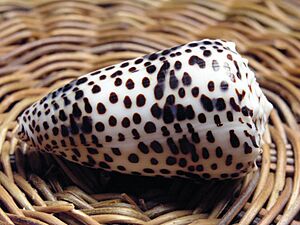Conus eburneus facts for kids
Quick facts for kids Conus eburneus |
|
|---|---|
 |
|
| A shell of Conus eburneus | |
| Conservation status | |
| Scientific classification | |
| Synonyms | |
|
The ivory cone (scientific name: Conus eburneus) is a type of sea snail. It's a marine mollusk, which means it's a creature with a soft body, often protected by a shell. This snail belongs to the Conidae family, also known as cone snails.
Cone snails are known for being hunters. They are also venomous. This means they can sting, so it's very important to never touch a live one.
There is also a special type, or subspecies, called Conus eburneus crassus. This subspecies was identified by G. B. Sowerby II in 1858.
What Does the Ivory Cone Look Like?
The shell of an adult ivory cone snail can be between 30 mm and 79 mm long. That's about the size of a small to medium-sized chicken egg.
The shell is usually white. It often has two or three light yellowish bands. You can also see very dark brown spots arranged in rows around the shell. These spots make the shell look like it has a cool pattern.
Where Do Ivory Cone Snails Live?
You can find this marine snail in warm, tropical waters. They live in the Indo-West Pacific region.
This area stretches from the coast of East Africa, near places like Madagascar and Chagos. It goes all the way to Australia, including the Northern Territory, Queensland, and Western Australia. You can also find them in Polynesia and the Ryukyu Islands in Japan. However, they are not found near Hawaii.
See More Ivory Cone Snail Pictures
Below are several color forms and one subspecies of the ivory cone snail.










